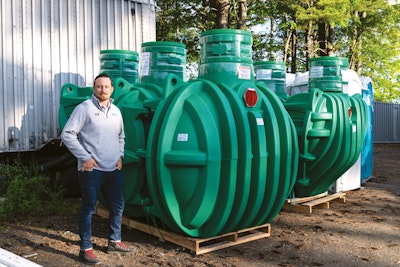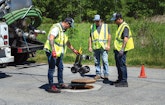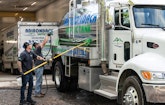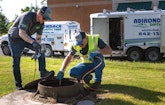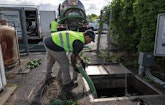
The Adirondack Septic team includes, from left, Jeff Zielinski, Jamie Rossi, Billy Gifford, Chad Town, Sylvia Zielinski, Ann Zielinski, Rick Zielinski, Cliff Marellus, Ken “Buzz” Yorks, Roger Larson and Dan Zielinski. (Photos by Chris Kendall)
Adirondack Septic Tank has reached the enviable goal of 50 years in business by following one simple goal: Consistently pleasing the customers.
“We haven’t made it 50 years without providing quality service and a good value to our customers,” says Rick Zielinski, current owner of the company and son of founders Al and Sylvia Zielinski. “We’ve got customers, we did work for their grandparents and parents, and now their children. We’ve had a lot of time to develop relationships with the sewer plant operators, the town supervisors, all the people who make decisions for the type of work we do. And they know who to call.”
“We’ve got an in-house unofficial motto,” adds Rick’s son Jeff Zielinski, 37, a project manager. “Whether we’re the first call or the last call, we’re the last call. We like a challenge, and we want to find a solution. We don’t walk away from a job undone.”
Good relationships extend to competitors, too. Rick says Adirondack’s competitors are comfortable when their customers call Adirondack to provide services the competitor doesn’t offer. “And in return,” Jeff says, “we’re content in taking, for example, a pump-replacement job from a guy who only pumps tanks, and then handing the tank pumping right back to him. We’re not going to try to steal his customer. It’s easier to be friendly with our local competitors and pass work back and forth.”
PROBLEM SOLVERS
In the local market, Adirondack is a larger operator, and it solves larger problems. One cropped up several years ago when baby food manufacturer Beech-Nut built a new plant. Like Adirondack it also is based in Amsterdam, New York, and is a longtime Adirondack client.
Beech-Nut knew from the outset that its waste flows would exceed the capacity of the sewer system if released in one slug, Jeff says. The solution is a 279,000-gallon, aboveground equalization tank. It accepts surges of plant wastewater, then steadily pumps smaller amounts into the municipal sewer system.
The problem was sludge buildup in the tank. This needs to be removed regularly so it doesn’t enter the municipal sewer, Jeff says. During the first week of July, the plant shuts down for regular maintenance, and the crew from Adirondack Septic spends a day cleaning the tank.
Beech-Nut workers drain most of it, and Adirondack technicians suck out the rest with a vacuum truck, Jeff says. Then two to three guys go in with personal protective equipment, following confined-space entry procedures, and with continuous forced air ventilation and air quality monitoring. They use a jetter to wash down the inside of the tank and suck up the wash water with a vacuum truck.
Tank washing was initially done twice a year, according to Dan Zielinski, 35, Rick’s other son and operations manager. As Adirondack techs gained experience with the job, they suggested Beech-Nut install an aeration system to promote waste digestion and reduce buildup. As a result, washing dropped to once a year. Beech-Nut doesn’t have to pause production twice, and it doesn’t have to pay twice for cleaning.
That reduced work for Adirondack, Jeff says. “But it’s probably added more than it’s taken because they have a sense of loyalty from us that has paid back dividends.”
BROAD SERVICE MENU
Adirondack Septic derives about 45% of business from its vacuum truck services, 15% from drain cleaning, 10% from onsite installations and excavating, 10% from camera inspection and location services, 10% from portable restrooms and 10% from pump station installation and maintenance.
“One of our biggest challenges is scheduling,” Dan says. “Some of the work is predictable. Most of it isn’t.” The company handles this with extensive cross training so anyone can jump into another job even if it’s not their primary role.
Among the calls that come in last-minute are from cruise boats. They sail the Mohawk River, which runs through Amsterdam and was part of the old Erie Canal system. Locks on the river close at 8 p.m., which sometimes means Adirondack technicians drive 30 or 40 miles to pump a holding tank because a ship was behind schedule and got stuck at a closed lock.
Next to the river is a train track, and that occasionally generates a last-minute call. Last winter, a maintenance train needed to have a holding tank pumped. “It sounded good on paper until we got down there,” Jeff says. “The tank we had to pump out was about 1,000 feet off the road between two sets of tracks with about an inch to spare on either side.”
“During a snowstorm,” Rick adds.
On the first attempt, the vacuum truck couldn’t get close enough to the railroad car. So the Adirondack technician waited until the train was ready to move, Jeff says. The train stopped at a road crossing just long enough for pumping, and then went on to its next destination.
CLEARING THE FOG
Grease traps are one of Adirondack’s commercial specialties. That began decades ago, Rick says, probably with an emergency call. Again, relationships come into play because a key to offering the service is having a well-run municipal plant willing to accept and treat grease, Jeff says. They have such a plant.
“I’ve had many conversations with the plant operators in the past about this,” Rick says, “and they understand that by pumping the grease traps it’s keeping the grease out of the citywide collections system.”
Because the job is messy, trucks are built with grease in mind. All of the 4,000-gallon vacuum trucks have full-hoist dumping tanks. This allows better draining for lumps of grease, as does use of 6-inch hoses. Newer trucks have an onboard water tank for washing hoses, a dedicated hose to vacuum traps, plus scrapers and other tools specific to grease, Dan says.
Keeping a grease trap system functioning also means cleaning inlets and pump stations, so the grease trap specialty also leads to quite a bit of drain cleaning work, he says.
Adirondack technicians always suggest a maintenance contract after responding to a customer’s first emergency grease trap call.
“Generally, when we get somebody on a regular maintenance schedule, they see a significant drop in emergency calls,” Jeff says. Clients also see other costs and frustrations drop, “because it’s not just the expense of the emergency call itself, which can be significant. It’s also the downtime, or you had to close your bathrooms and kitchen on a Friday night with a full house.”
PORTABLE SANITATION
Adirondack has been supplying portable restrooms since the 1980s, at first as fill-in work, Rick says. Today, one technician is dedicated full-time to the restroom division.
There are 225 to 250 units from Satellite and T.S.F., including standard portables, flushables, ADA-compliant units and hand-wash stations. There is also a 16-foot Forest River, an older 20-foot, as well as shop-built restroom trailers. During the busy season, other employees are pulled in to help with portable sanitation duties, Dan says. For the rest of the year, one technician can handle the workload.
BUILT FOR WORK
A diverse company like Adirondack must maintain a diverse inventory of equipment. The pumping fleet consists of:
• 2022 Peterbilt 348 with a Pik Rite 4,000-gallon aluminum dump tank and NVE 4310 blower
• 2021 Peterbilt 348 with an Amthor International 4,000-gallon aluminum dump tank and NVE 4307 blower
• 2020 Peterbilt 337 with an Amthor International 2,500-gallon aluminum tank and NVE 4307 blower
• 2002 Freightliner FL112 with a Presvac Systems 4,000-gallon aluminum dump tank and Utile pump
• 2006 International 4300 with a 2,500-gallon aluminum tank and Utile pump
Portable restrooms are serviced with a 2019 Ford F-550 with an Amthor International aluminum dual-compartment tank, Conde pump and Anthony liftgate; and a 2008 Ford F-550 with a Dyna-Vac stainless steel dual-compartment tank, Conde pump and Anthony liftgate.
For excavation, they use Kubota KX080-3, Kubota KX121-3, Kubota SVL75-2 tracked skid-steers and a New Holland TC40 tractor with a backhoe.
Jetters are from US Jetting. Cameras and locators are from CUES and Vivax-Metrotech.
The Adirondack Septic team consists of: Rick Zielinski, president and owner; Anne Zielinski, (Rick’s wife) office manager; Jeff Zielinski, project manager; Dan Zielinski, operations manager; Jamie Rossi, foreman for power jetting and excavation; Roger Larson, portable sanitation technician; Chad Town, service technician for pumping and power jetting; Ken “Buzz” Yorks, service technician for pumping; Billy Gifford, service technician for power jetting; Cliff Marcellus, service technician for power jetting. All employees are cross-trained.
WHY NEW EQUIPMENT?
The 2020 and 2022 Peterbilts break a long tradition at Adirondack. Someone else built them out. “We used to build all our trucks,” Rick says. “Back when we started, there was more time than money, so we had to do things ourselves.” As the business grew and maintenance work generated steady revenue year-round, winter was no longer a slow season, he says. Now it’s a more effective use of time to have someone else do the building.
New equipment also means the Adirondack team can do more work without adding more people, Rick says. It’s a question of putting the right people in the right place with the right tools, he says.
They’re constantly looking at equipment, Rick says, reading trade magazines to see what equipment other people are using and how they use it. When they’re close to a decision, the WWETT Show is invaluable for side-by-side comparisons, he says.
Equipment purchases are never on impulse, Jeff says. Their CUES Flexitrax C550c camera system is an example. For years technicians did mainline inspections by driving push cameras with a jetter. During that time, the Zielinskis gauged the demand in their area, he says. Last, they went to the WWETT Show, looked at crawler camera systems in person, and made their investment.
“And then by the time we do pull the trigger, we’ve got a list of jobs to put it right to work,” Jeff says.
STAYING HUNGRY
A significant portion of the business has grown from Adirondack’s selection as a Norweco distributor since 2012, Jeff says. Most of that business is focused on Singulair Green units. Adirondack either installs and services, or it provides components to other contractors and then takes over maintenance. The product works well on small lots near surface water, Rick says, and the Adirondack foothills and mountains of their area are full of lake homes.
If service has been the key to 50 years of history, there is another for the future 50 years. Staying hungry, Dan says.
“You have to come in every day willing to do whatever it is, and it can vary a lot, whether it’s fixing something on a truck so the guys can get out the door in the morning, or sitting in the machine digging a hole, doing whatever needs to be done,” he says. “One day you’re in the inner city, and the next you’re working in a $10 million house. We see everything.”
